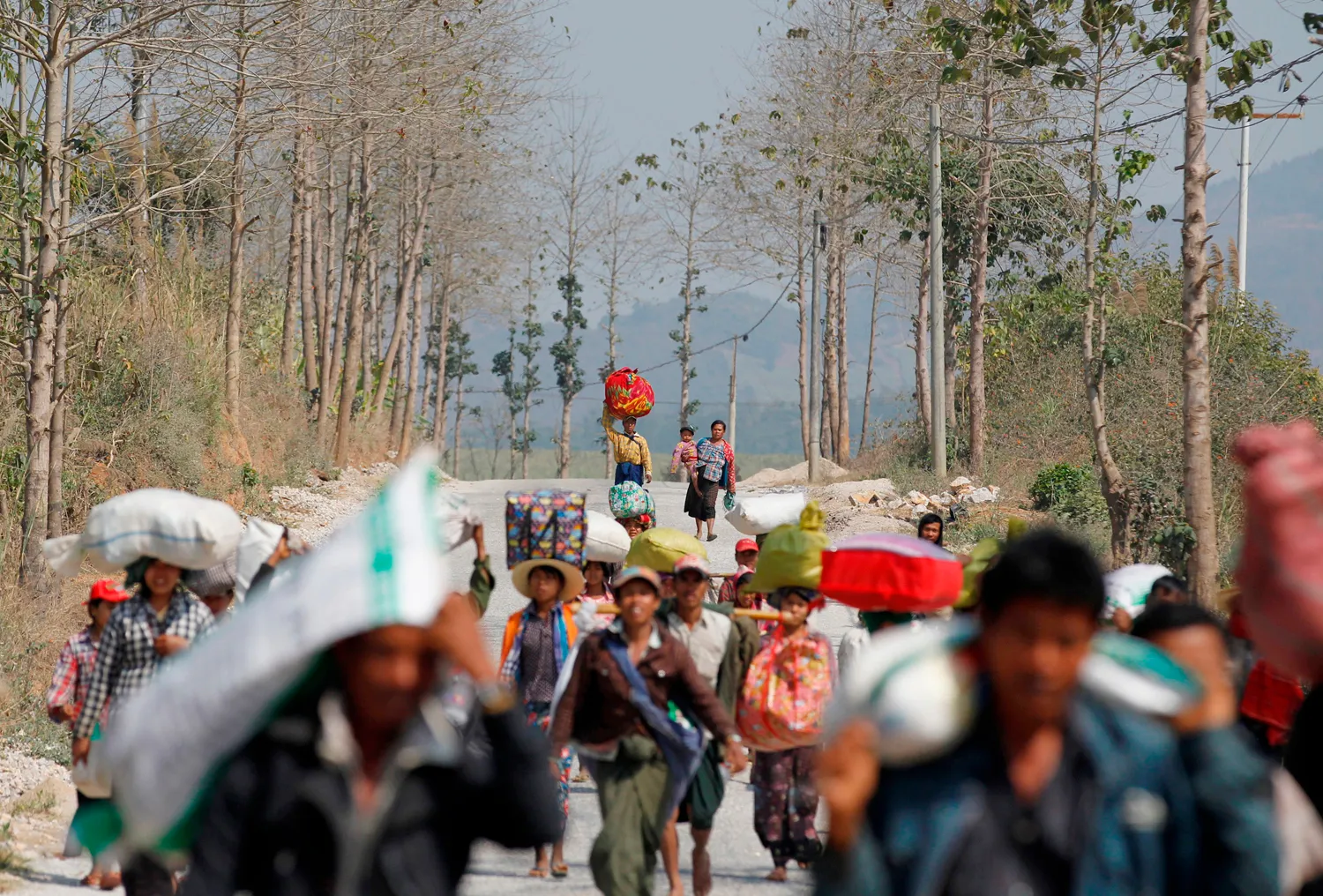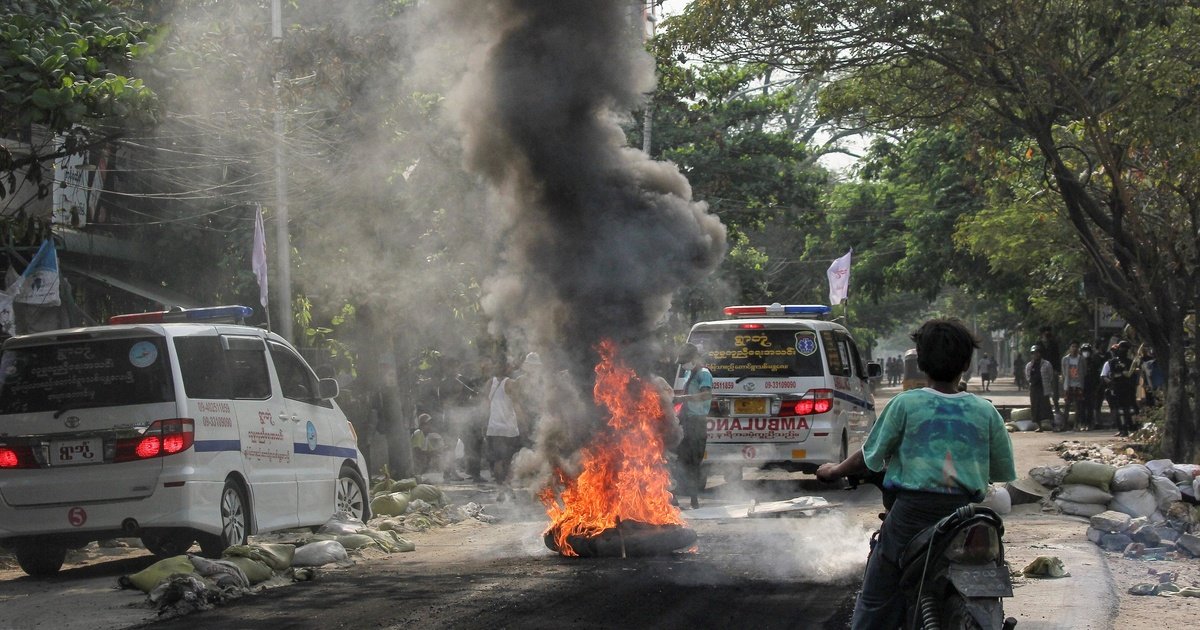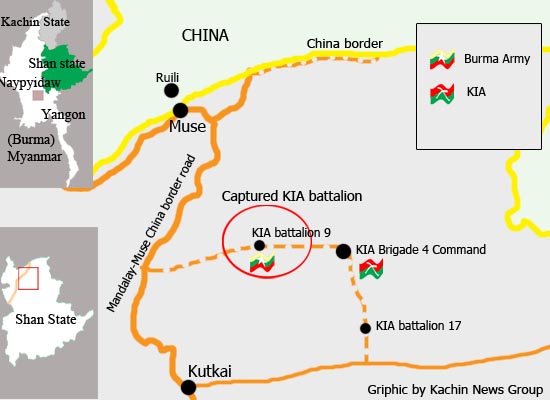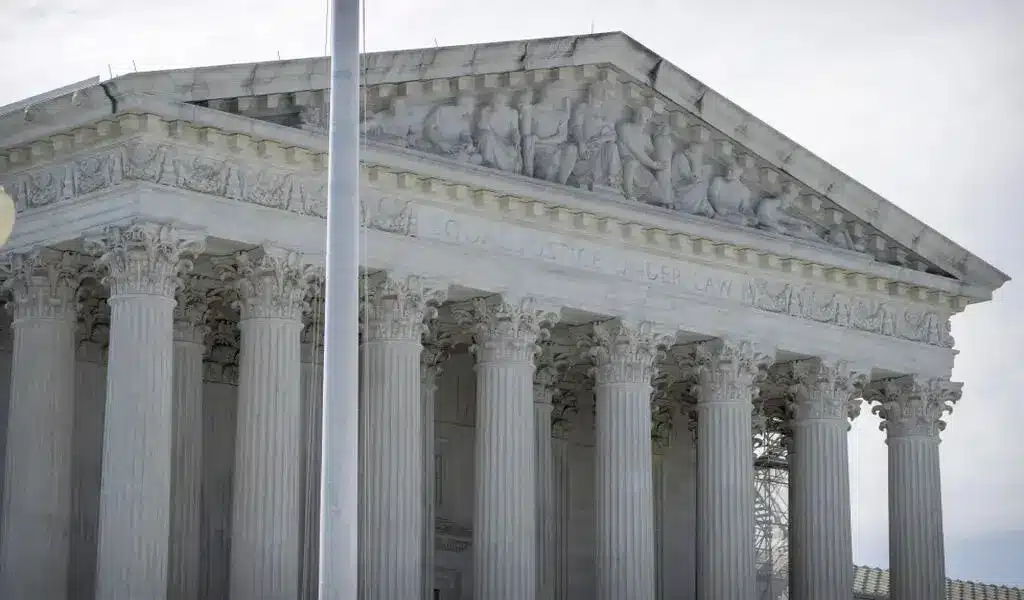News
UN Reports Fighting in Northern Myanmar Has Displaced Over 50,000 Civilians

The United Nations reported on Friday that violence in northern Myanmar since an alliance of ethnic armed groups launched an offensive against the military two weeks ago has displaced nearly 50,000 people.
Analysts assert that the military confrontation in northern Shan state, close to the Chinese border, which has been ongoing for the past two weeks, presents the junta with its most significant military obstacle since assuming jurisdiction in 2021.
Myanmar National Democratic Alliance Army (MNDAA), Ta’ang National Liberation Army (TNLA), and Arakan Army (AA) claim to have obstructed vital trade routes to China and occupied dozens of military outposts.
As of November 9th, the United Nations Office for the Coordination of Humanitarian Affairs (UNOCHA) reported in an update that the number of individuals compelled to abandon their homes in northern Shan had approached 50,000.
Internet and phone services were disrupted outside of Lashio township in Shan state, which houses the military’s northeastern command. This impeded humanitarian responses to the conflict, according to UNOCHA.
It stated that limitations on cash availability and transportation restrictions impeded the ability of local humanitarian organisations to distribute assistance.

Conflicts between the military and its adversaries in the neighbouring Sagaing region and Kachin state have displaced an additional 40,000 individuals since early November, according to UNOCHA.
The junta-appointed president warned earlier this week that if the military failed to “manage” the combat, the country could “splinter into various parts.” The military has made few comments regarding the surprise offensive.
Volatile communications and the inaccessibility of the treacherous, jungle-covered region—which contains pipelines that deliver gas and oil to China—make it challenging to confirm casualty counts.
A significant junta ally and munitions supplier, Beijing confirmed Chinese casualties in the Myanmar conflict on Tuesday.
An individual representing the foreign ministry refrained from specifying the location of the incident or the number of fatalities or injuries among the Chinese.
Over a dozen ethnic armed groups reside in the borderlands of Myanmar; some of these groups have engaged in protracted conflicts with the military regarding autonomy and the control of valuable resources.
Since the coup, some have provided training and equipment to the more recent “People’s Defence Forces” (PDF), which have emerged to oppose the military’s violent suppression of opposition.

Earlier this week, multiple PDF factions asserted control over the Sagaing region town of Kawlin, which is historical and culturally significant to the Bamar people and has served as a military recruiting centre. Residents of the area were inaccessible to AFP due to the extensive downtime of phone lines and internet connections.
Sagaing, which shares borders with the states of Shan and Kachin, has emerged as an epicentre of junta resistance. Decades of PDF organisations are active throughout Sagaing, an area where the military is under suspicion of torching villages and murdering their inhabitants.
In the interim, rebel factions in Myanmar assert that they have amassed a string of victories on the battlefield against the governing junta, posing what security analysts consider to be the greatest challenge to the military’s hold on the country since a coup in 2021 overthrew a civilian government and seized power.
The surprise offensive, which originated in the northern region, has, according to the United Nations, displaced tens of thousands of people along Myanmar’s border with China. Opposition from Beijing and strain in the military’s rapport with one of its limited allies have resulted from the disruption of border businesses caused by the campaign.
Since the rebellion, pro-democracy insurgents in the country’s interior have joined forces with ethnic armed groups along its borders, thereby subjecting the Myanmar military to attacks from multiple fronts during its nearly three-year civil war. The military has employed ruthless tactics in an attempt to quell the resistance, which human rights organisations assert are likely war crimes.

A coalition of three ethnic armed groups that had largely abstained from the conflict until October 27th launched an abrupt, well-coordinated offensive in the province of Shan, located in the strategic northern region adjacent to Laos, Thailand, and China.
The assertion that the Three Brotherhood Alliance had seized control of over a hundred military outposts, main highways, and border crossings in the span of ten days is anticipated to have a financial impact on the junta. Social media platforms are filled with images and videos that depict rebel soldiers triumphantly marching through townships while posing in front of weaponry purportedly stolen from military battalions.
A junta spokesman, General Zaw Min Tun, made the unprecedented disclosure to a state broadcaster last week that the military had relinquished control of three towns in Shan.
“It took us a long time to plan this operation,” Tar Aik Kyaw, an alliance spokesman for the Ta’Ang National Liberation Army, explained in an interview. “Everything had to be methodically prepared… in order to reduce casualties on our side.”
He further stated that the Arakan Army and the Myanmar National Democratic Alliance Army, two allied organisations of the Ta’Ang National Liberation Army, “welcome any other group fighting against the military.”
Myanmar Witness, an organisation that has been verifying information about the civil war, has initiated the collection of a substantial quantity of visual evidence of the offensive, according to a spokesman for the organisation. “This is a significant development from a region of the country where conflict incidents on open source channels are typically infrequent,” spokesman Matt Freear explained.

In the days following the northern offensive, insurgents and rebels in the southern and central regions of the nation launched their own assaults. Towards the vicinity of Mandalay, in the Sagaing region, pro-democracy organisations announced on Tuesday that they had reclaimed two townships previously ruled by the military. This marked the first time since the military took control of the area.
Many of the country’s armed groups are too minor to overthrow the military on their own, but they have demonstrated an unprecedented level of cooperation over the past week, according to Zachary Abuza, a scholar of Southeast Asian security issues at the National War College in Washington. “They are moving in unison and paying attention to one another. “That is the intriguing aspect of this situation.”
The Three Brotherhood Alliance comprises factions that maintain strong affiliations with China and rank among the most formidable armed actors in the region adjacent to Myanmar’s border. The alliance, in contrast to certain other rebel factions, refrained from promptly aligning with the resistance following the coup. Instead, it proclaimed itself neutral with regard to the conflict between the military and the pro-democracy movement.
However, as the junta escalated bombardment across the country this year, alliance units commenced engagements with military forces in Shan. The proliferation of illicit activities in regions under military control further escalated tensions. Alliance leaders stated that the elimination of cyberscam operations, which have flourished in the lawless region of Kokang, was one of the objectives of the assault.

The conflict has obstructed trade and travel between northern Shan and China, potentially preventing the military from obtaining a significant source of funding.
China announced on Monday, in response to the offensive, that Assistant Foreign Minister Nong Rong had visited Myanmar over the weekend and urged officials to “maintain stability” along the border. The extent to which Beijing was cognizant of the alliance’s strategy for an unexpected assault is not immediately evident.
Commemorating the offensive as a pivotal moment in the conflict, pro-democracy movement leaders and supporters have expressed their delight. The rebel groups, however, are operating for their own benefit, and their connections to the pro-democracy movement are, at best, tenuous, according to analysts. In recent days, the chief military commander of the military, Min Aung Hlaing, has also pledged to launch counteroffensives.
Subsequent to its October seizure of two military encampments in the vicinity of Shan, an additional rebel faction known as the Kachin Independence Army has encountered an onslaught of artillery and airstrikes. People have been in concealment at the group’s command centre in the town of Laiza for over a week, according to Col. Naw Bu, a spokesman for the organisation.
Myanmar Army Accused of Using Thai Citizens as Human Shields
Myanmar Army Accused of Using Thai Citizens as Human Shields

News
Google’s Search Dominance Is Unwinding, But Still Accounting 48% Search Revenue

Google is so closely associated with its key product that its name is a verb that signifies “search.” However, Google’s dominance in that sector is dwindling.
According to eMarketer, Google will lose control of the US search industry for the first time in decades next year.
Google will remain the dominant search player, accounting for 48% of American search advertising revenue. And, remarkably, Google is still increasing its sales in the field, despite being the dominating player in search since the early days of the George W. Bush administration. However, Amazon is growing at a quicker rate.
Google’s Search Dominance Is Unwinding
Amazon will hold over a quarter of US search ad dollars next year, rising to 27% by 2026, while Google will fall even more, according to eMarketer.
The Wall Street Journal was first to report on the forecast.
Lest you think you’ll have to switch to Bing or Yahoo, this isn’t the end of Google or anything really near.
Google is the fourth-most valued public firm in the world. Its market worth is $2.1 trillion, trailing just Apple, Microsoft, and the AI chip darling Nvidia. It also maintains its dominance in other industries, such as display advertisements, where it dominates alongside Facebook’s parent firm Meta, and video ads on YouTube.
To put those “other” firms in context, each is worth more than Delta Air Lines’ total market value. So, yeah, Google is not going anywhere.
Nonetheless, Google faces numerous dangers to its operations, particularly from antitrust regulators.
On Monday, a federal judge in San Francisco ruled that Google must open up its Google Play Store to competitors, dealing a significant blow to the firm in its long-running battle with Fortnite creator Epic Games. Google announced that it would appeal the verdict.
In August, a federal judge ruled that Google has an illegal monopoly on search. That verdict could lead to the dissolution of the company’s search operation. Another antitrust lawsuit filed last month accuses Google of abusing its dominance in the online advertising business.
Meanwhile, European regulators have compelled Google to follow tough new standards, which have resulted in multiple $1 billion-plus fines.

Pixa Bay
Google’s Search Dominance Is Unwinding
On top of that, the marketplace is becoming more difficult on its own.
TikTok, the fastest-growing social network, is expanding into the search market. And Amazon has accomplished something few other digital titans have done to date: it has established a habit.
When you want to buy anything, you usually go to Amazon, not Google. Amazon then buys adverts to push companies’ products to the top of your search results, increasing sales and earning Amazon a greater portion of the revenue. According to eMarketer, it is expected to generate $27.8 billion in search revenue in the United States next year, trailing only Google’s $62.9 billion total.
And then there’s AI, the technology that (supposedly) will change everything.
Why search in stilted language for “kendall jenner why bad bunny breakup” or “police moving violation driver rights no stop sign” when you can just ask OpenAI’s ChatGPT, “What’s going on with Kendall Jenner and Bad Bunny?” in “I need help fighting a moving violation involving a stop sign that wasn’t visible.” Google is working on exactly this technology with its Gemini product, but its success is far from guaranteed, especially with Apple collaborating with OpenAI and other businesses rapidly joining the market.
A Google spokeswoman referred to a blog post from last week in which the company unveiled ads in its AI overviews (the AI-generated text that appears at the top of search results). It’s Google’s way of expressing its ability to profit on a changing marketplace while retaining its business, even as its consumers steadily transition to ask-and-answer AI and away from search.

Google has long used a single catchphrase to defend itself against opponents who claim it is a monopoly abusing its power: competition is only a click away. Until recently, that seemed comically obtuse. Really? We are going to switch to Bing? Or Duck Duck Go? Give me a break.
But today, it feels more like reality.
Google is in no danger of disappearing. However, every highly dominating company faces some type of reckoning over time. GE, a Dow mainstay for more than a century, was broken up last year and is now a shell of its previous dominance. Sears declared bankruptcy in 2022 and is virtually out of business. US Steel, long the foundation of American manufacturing, is attempting to sell itself to a Japanese corporation.
SOURCE | CNN
News
2024 | Supreme Court Won’t Hear Appeal From Elon Musk’s X Platform Over Warrant In Trump Case

Washington — Trump Media, The Supreme Court announced Monday that it will not hear an appeal from social media platform X about a search warrant acquired by prosecutors in the election meddling case against former President Donald Trump.
The justices did not explain their rationale, and there were no recorded dissents.
The firm, which was known as Twitter before being purchased by billionaire Elon Musk, claims a nondisclosure order that prevented it from informing Trump about the warrant obtained by special counsel Jack Smith’s team violated its First Amendment rights.
The business also claims Trump should have had an opportunity to exercise executive privilege. If not reined in, the government may employ similar tactics to intercept additional privileged communications, their lawyers contended.
Supreme Court Won’t Hear Appeal From Elon Musk’s X Platform Over Warrant In Trump Case
Two neutral electronic privacy groups also joined in, urging the high court to hear the case on First Amendment grounds.
Prosecutors, however, claim that the corporation never shown that Trump utilized the account for official purposes, therefore executive privilege is not a problem. A lower court also determined that informing Trump could have compromised the current probe.

Trump utilized his Twitter account in the weeks preceding up to his supporters’ attack on the Capitol on January 6, 2021, to spread false assertions about the election, which prosecutors claim were intended to create doubt in the democratic process.
The indictment describes how Trump used his Twitter account to encourage his followers to travel to Washington on Jan. 6, pressuring Vice President Mike Pence to reject the certification, and falsely claiming that the Capitol crowd, which battered police officers and destroyed glass, was peaceful.
Supreme Court Won’t Hear Appeal From Elon Musk’s X Platform Over Warrant In Trump Case
That case is now moving forward following the Supreme Court’s verdict in July, which granted Trump full immunity from criminal prosecution as a former president.
The warrant arrived at Twitter amid quick changes implemented by Musk, who bought the company in 2022 and has since cut off most of its workforce, including those dedicated to combating disinformation and hate speech.
SOURCE | AP
News
The Supreme Court Turns Down Biden’s Government Appeal in a Texas Emergency Abortion Matter.

(VOR News) – A ruling that prohibits emergency abortions that contravene the Supreme Court law in the state of Texas, which has one of the most stringent abortion restrictions in the country, has been upheld by the Supreme Court of the United States. The United States Supreme Court upheld this decision.
The justices did not provide any specifics regarding the underlying reasons for their decision to uphold an order from a lower court that declared hospitals cannot be legally obligated to administer abortions if doing so would violate the law in the state of Texas.
Institutions are not required to perform abortions, as stipulated in the decree. The common populace did not investigate any opposing viewpoints. The decision was made just weeks before a presidential election that brought abortion to the forefront of the political agenda.
This decision follows the 2022 Supreme Court ruling that ended abortion nationwide.
In response to a request from the administration of Vice President Joe Biden to overturn the lower court’s decision, the justices expressed their disapproval.
The government contends that hospitals are obligated to perform abortions in compliance with federal legislation when the health or life of an expectant patient is in an exceedingly precarious condition.
This is the case in regions where the procedure is prohibited. The difficulty hospitals in Texas and other states are experiencing in determining whether or not routine care could be in violation of stringent state laws that prohibit abortion has resulted in an increase in the number of complaints concerning pregnant women who are experiencing medical distress being turned away from emergency rooms.
The administration cited the Supreme Court’s ruling in a case that bore a striking resemblance to the one that was presented to it in Idaho at the beginning of the year. The justices took a limited decision in that case to allow the continuation of emergency abortions without interruption while a lawsuit was still being heard.
In contrast, Texas has been a vocal proponent of the injunction’s continued enforcement. Texas has argued that its circumstances are distinct from those of Idaho, as the state does have an exemption for situations that pose a significant hazard to the health of an expectant patient.
According to the state, the discrepancy is the result of this exemption. The state of Idaho had a provision that safeguarded a woman’s life when the issue was first broached; however, it did not include protection for her health.
Certified medical practitioners are not obligated to wait until a woman’s life is in imminent peril before they are legally permitted to perform an abortion, as determined by the state supreme court.
The state of Texas highlighted this to the Supreme Court.
Nevertheless, medical professionals have criticized the Texas statute as being perilously ambiguous, and a medical board has declined to provide a list of all the disorders that are eligible for an exception. Furthermore, the statute has been criticized for its hazardous ambiguity.
For an extended period, termination of pregnancies has been a standard procedure in medical treatment for individuals who have been experiencing significant issues. It is implemented in this manner to prevent catastrophic outcomes, such as sepsis, organ failure, and other severe scenarios.
Nevertheless, medical professionals and hospitals in Texas and other states with strict abortion laws have noted that it is uncertain whether or not these terminations could be in violation of abortion prohibitions that include the possibility of a prison sentence. This is the case in regions where abortion prohibitions are exceedingly restrictive.
Following the Supreme Court’s decision to overturn Roe v. Wade, which resulted in restrictions on the rights of women to have abortions in several Republican-ruled states, the Texas case was revisited in 2022.
As per the orders that were disclosed by the administration of Vice President Joe Biden, hospitals are still required to provide abortions in cases that are classified as dire emergency.
As stipulated in a piece of health care legislation, the majority of hospitals are obligated to provide medical assistance to patients who are experiencing medical distress. This is in accordance with the law.
The state of Texas maintained that hospitals should not be obligated to provide abortions throughout the litigation, as doing so would violate the state’s constitutional prohibition on abortions. In its January judgment, the 5th United States Circuit Court of Appeals concurred with the state and acknowledged that the administration had exceeded its authority.
SOURCE: AP
SEE ALSO:
Could Last-Minute Surprises Derail Kamala Harris’ Campaign? “Nostradamus” Explains the US Poll.
-

 News4 years ago
News4 years agoLet’s Know About Ultra High Net Worth Individual
-
Entertainment2 years ago
Mabelle Prior: The Voice of Hope, Resilience, and Diversity Inspiring Generations
-
News11 years ago
Enviromental Groups Tell Mekong Leaders Lao Dam Evaluation Process Flawed
-

 Health4 years ago
Health4 years agoHow Much Ivermectin Should You Take?
-

 Tech3 years ago
Tech3 years agoTop Forex Brokers of 2023: Reviews and Analysis for Successful Trading
-

 Lifestyles3 years ago
Lifestyles3 years agoAries Soulmate Signs
-

 Entertainment3 years ago
Entertainment3 years agoWhat Should I Do If Disney Plus Keeps Logging Me Out of TV?
-

 Health3 years ago
Health3 years agoCan I Buy Ivermectin Without A Prescription in the USA?


